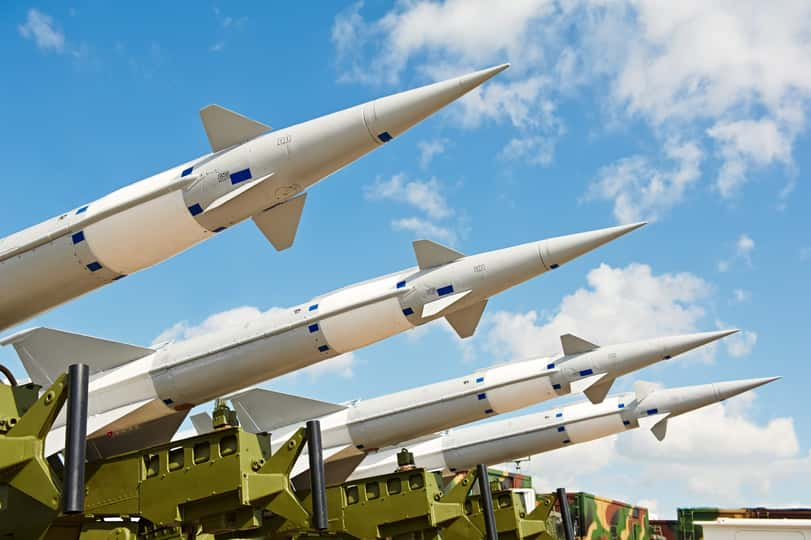The dynamic and evolving nature of threats in today’s world underscores the critical need for ongoing innovation in air defense technologies. Companies operating in this sector are making substantial investments in research and development, positioning themselves as leaders in the field of technological advancements.
Given the backdrop, in this article, I have evaluated the fundamentals of two air defense stocks: The Boeing Company (BA) and CACI International Inc (CACI), to determine which one could be a better portfolio addition. Before we dive into the comparison of these stocks, let us take a peek into the broader industry outlook.
The defense sector experienced significant momentum after Russia’s invasion of Ukraine last year. With the ongoing conflict and increasing concerns about nuclear threats, numerous governments worldwide are further increasing their defense spending allocations.
Global military spending reached a record high of $2.20 trillion last year, with the United States accounting for a significant $877 billion, accounting for nearly 40% of the total expenditure.
In terms of military spending as a percentage of GDP, the United States allocated 3.5%. According to the U.S. Congressional Budget Office, the outlays for defense are expected to reach $1.10 trillion by 2033.
Moreover, amid ongoing geopolitical concerns, nations are placing greater emphasis on fortifying their air defense capabilities to safeguard their territories against potential threats.
This has led to a positive outlook for the global air defense systems market, which is projected to grow to around $65.05 billion by 2032, with a 5.3% CAGR. Additionally, the global aerospace and defense market exhibited strong growth, reaching $855.62 billion in 2023 and is expected to expand to $1.08 trillion in 2027, growing at a 5.9% CAGR.
Considering the solid industry prospects, BA and CACI are expected to benefit from the industry’s tailwinds. However, in terms of price performance, CACI has gained 14.3% over the past six months compared to BA’s 1.2% decline over the same period.
Moreover, CACI’s shares have surged 6.9% year-to-date to close the last trading session at $321.45. On the other hand, BA’s shares gained 6.2% year-to-date to close the last trading session at $202.37.
Keeping all these factors in mind, let us dive into the fundamentals of the featured stocks to determine which Air/Defense Services stock could be a better pick.
Recent Developments
On September 11, BA announced that Vietnam Airlines had chosen BA’s 737 MAX family to strengthen its single-aisle aircraft fleet. In addition, Vietnam Airlines expressed its commitment to ordering 50 units of the 737-8 airplanes.
With their improved fuel efficiency and environmental credentials, the 737 MAX aircrafts are poised to offer top-tier flexibility to accommodate the burgeoning aviation market in Vietnam. Officials from the United States and Vietnam believe this commitment will enhance employment opportunities in both nations and reinforce their bilateral economic partnership.
On August 8, CACI announced a multi-year Strategic Collaboration Agreement (SCA) with Amazon Web Services (AWS). This collaboration aims to further advance CACI’s utilization of AWS services as a trusted provider, delivering secure, agile, and innovative solutions that can be swiftly adopted by both enterprise and mission-focused customers within the U.S. government.
Recent Financial Results
For the fiscal second quarter ended June 30, 2023, BA’s total revenues rose 18.4% year-over-year to $19.75 billion, while its sales of products increased 19.1% from the year-ago value to $16.69 million. However, its net loss and loss per share amounted to $149 million and $0.25 versus a net income and EPS of $193 million and $0.32 in the same period last year, respectively.
On the contrary, CACI’s revenues for the fiscal fourth quarter (ended June 30, 2023) increased 3.7% year-over-year to $1.70 billion, while its income from operations grew 24.2% from the year-ago value to $148.79 million. Furthermore, the company’s net income and EPS amounted to $107.77 million and $4.68, up 15.9% and 19.1% from the prior-year quarter, respectively.
Past and Expected Financial Performance
BA’s revenue grew at a 3.4% CAGR over the past three years. Analysts expect BA’s revenue for the third quarter (ending September 2023) to increase 19.5% year-over-year to $19.07 billion. Whereas its EPS for the ongoing quarter is expected to come in at negative $1.51. Moreover, the company failed to surpass its EPS estimates in three of the trailing four quarters.
Conversely, over the past three years, CACI’s revenue grew at a CAGR of 5.4%. Analysts expect CACI’s revenue and EPS for the first quarter of fiscal 2024 (ending September 2023) to increase 4.9% and 3.9% year-over-year to $1.68 billion and $4.53, respectively. Additionally, the company topped its revenue and EPS estimates in three of the trailing four quarters.
Valuation
In terms of forward EV/EBIT, BA is currently trading at 166.43x, significantly higher than CACI, which is trading at 14.77x. Moreover, BA’s forward EV/EBITDA multiple of 53.35x is 345.3% higher than CACI’s 11.98x. Additionally, BA’s forward Price/Cash Flow multiple of 29.76x is 85.7% higher than CACI’s 16.03x.
Thus, CACI is more affordable.
Profitability
CACI is more profitable, with a trailing-12-month gross profit margin of 34.31%, compared to BA’s 9.11%. Additionally, CACI’s trailing-12-month EBITDA margin of 5.74% is higher than BA’s 1.46%. Furthermore, CACI’s trailing-12-month net income margin of 5.74% compares to BA’s negative net income margin of 6.08%.
POWR Ratings
BA has an overall rating of C, which equates to a Neutral in our proprietary POWR Ratings system. Conversely, CACI has an overall rating of B, translating to Buy. The POWR Ratings are calculated considering 118 different factors, with each factor weighted to an optimal degree.
Our proprietary rating system also evaluates each stock based on eight distinct categories. BA has a D grade for Stability, justified by its 24-month beta of 1.11. Conversely, CACI’s B grade for stability is justified by its 24-month beta of 0.66.
Moreover, BA’s C grade for Sentiment is in sync with its mixed analyst estimates for the to-be-reported quarter. On the other hand, CACI’s B grade for Sentiment is justified by its favorable analyst estimates for the to-be-reported quarter.
Among the 71 stocks in the Air/Defense Services industry, BA is ranked #50, while CACI is ranked #7.
Beyond what we’ve stated above, we have also rated both stocks for Growth, Value, Momentum, and Quality. Click here to view BA’s ratings. Get all CACI ratings here.
The Winner
While both BA and CACI are well-positioned to capitalize on rising defense spending and other positive industry trends, CACI’s strong financial performance in its recent quarter, positive analyst estimates, and attractive valuation in comparison to BA indicate that CACI could be a better buy.
Our research shows that the odds of success increase when one invests in stocks with an overall rating of Strong Buy. View all the top-rated stocks in the Air/Defense Services industry here.
43 Year Investment Pro Shares Top Picks
Steve Reitmeister is best known for his timely market outlooks & unique trading plans to stay on the right side of the market action. Click below to get his latest insights…
Steve Reitmeister’s Trading Plan & Top Picks >
Want More Great Investing Ideas?
BA shares were trading at $202.28 per share on Thursday afternoon, down $0.09 (-0.04%). Year-to-date, BA has gained 6.19%, versus a 14.91% rise in the benchmark S&P 500 index during the same period.
About the Author: Anushka Mukherjee

Anushka's ultimate aim is to equip investors with essential knowledge that empowers them to make well-informed investment choices and attain sustained financial prosperity in the long run. More...
More Resources for the Stocks in this Article
| Ticker | POWR Rating | Industry Rank | Rank in Industry |
| BA | Get Rating | Get Rating | Get Rating |
| CACI | Get Rating | Get Rating | Get Rating |






